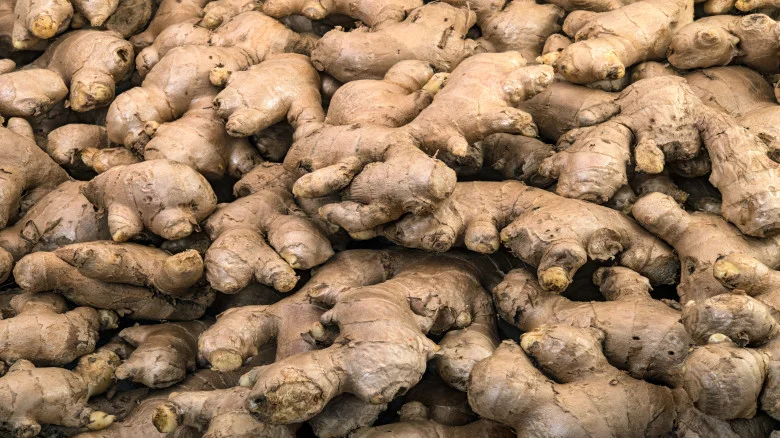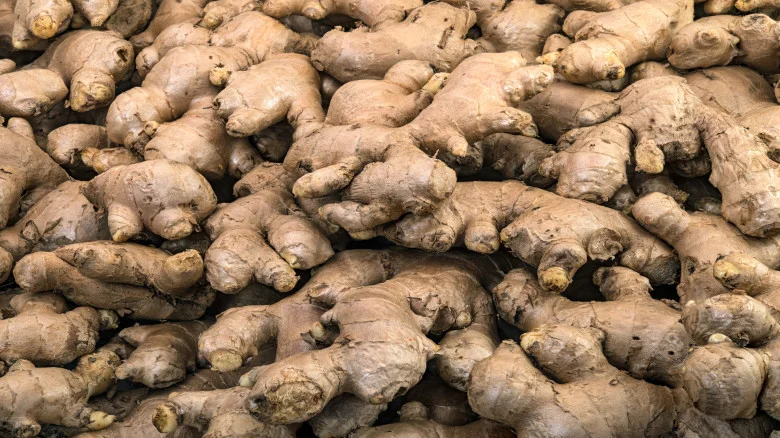Latest News
Ginger Cultivation in Kerala: Top 1 Benefits, Best Growing Tips & Fertilizers

Overview of this Blog
Ginger Cultivation is an important spice in Kerala, grown in humid areas with well-drained soil. It is planted in May or earlier with proper irrigation. Seed rhizomes are used for planting, and fertilizers help its growth. Ginger has many health benefits, including easing nausea, motion sickness, and digestive issues due to its anti-inflammatory properties.
One of the most significant spices in Kerala is ginger. Ginger is a thin, evergreen plant. The spice is the underground rhizome of this tropical plant, prepared or unprocessed. Although it is grown across the nation, the kind cultivated in Kerala is said to be of higher quality. It needs well-ventilated, well-drained soil and grows best in humid environments. In Kerala’s coconut groves, ginger is a good intercrop. In newly established rubber plantations, it may be planted as an intercrop for the first three to four years.

When should do Ginger Cultivation?
In the West Coast of India, the first two weeks of May are ideal for Ginger Cultivation because they provide pre-monsoon rainfall. It may be planted well in advance, from the middle of February to the beginning of March, in an irrigated garden. Among the well-known native cultivars are Mannathody, Himachal, Ernad, Wayanad, Valluvanad, Maran, Kuruppampadi, and Nadia. Ginger Cultivation
How should Ginger Cultivation?
Rhizome segments referred to as seed rhizomes are used to Ginger Cultivation. Properly conserved seed rhizomes are chopped into tiny segments about 2.5–5.0 cm in length and weighing 20–25 g, with one or two healthy buds on each piece. The rate of seed varies according on the growing technique used and the geographical location. Typically, the harvest lasts for eight or nine months, from April or May to December or January. Ginger is planted in rows with spacing of 20 to 25 cm between each plant, spaced 30 cm apart. At the specified spacing, bits of seed rhizomes with at least one bud, measuring 3-5 cm in length and weighing 30-35 g each are planted. An acre of green ginger is expected to generate between six and ten tons on average. Ginger Cultivation The percentage of dried ginger that recovers ranges from 16 to 25%.
Fertilizers
Fertilizers used to Ginger Cultivation, On the 80th day, apply 12 kg of potash and 12 kg of nitrogen per acre. On the 120th day, the last dosage of 12 kg of nitrogen and 12 kg of potash per acre should be administered. The optimal growing conditions for ginger plants are areas with moderate shade and four to five hours of indirect sunshine. Ginger thrives in hot, muggy weather and in rich, nutrient-rich soil. The plants thrive in full sun in our chilly environment, but they could require some partial shade in warmer southern climates. Ginger Cultivation

Ginger’s health advantages
Migraine sufferers have found that Ginger Cultivation is an effective treatment for nausea, motion sickness, morning sickness, and other digestive disorders. With its anti-inflammatory qualities, improved digestive reactivity, and hormone modulation that aids in blood pressure stabilization and general body quiet, this natural wonder soothes an upset stomach.
Conclusion:
Ginger cultivation is not only a rewarding agricultural practice but also a valuable contribution to health and wellness. Kerala’s humid climate, rich soil, and sustainable farming practices make it one of the best regions in India for growing high-quality ginger. With the right timing, proper irrigation, and nutrient management, farmers can achieve impressive yields, both in terms of quantity and quality. The use of seed rhizomes, timely application of fertilizers, and understanding the ideal growing conditions are crucial to a successful harvest.
Ginger is more than just a spice — it’s a natural remedy with a wide range of health benefits. Its anti-inflammatory properties, ability to relieve nausea, improve digestion, and regulate blood pressure make it a staple in traditional medicine and modern wellness routines alike. For farmers, it offers a sustainable source of income, especially when intercropped with coconut or rubber plantations.
As demand for organic and medicinal crops continues to rise, ginger stands out as a smart and sustainable choice for cultivators in Kerala and beyond. By embracing proper cultivation practices, farmers can tap into the full potential of this remarkable crop while contributing to both economic growth and holistic health.












